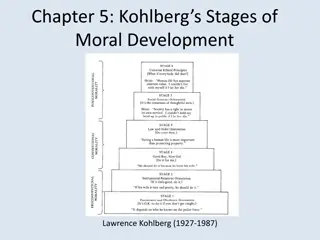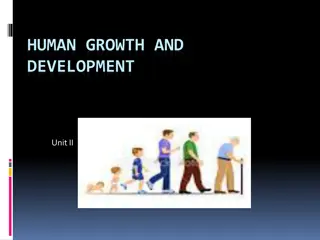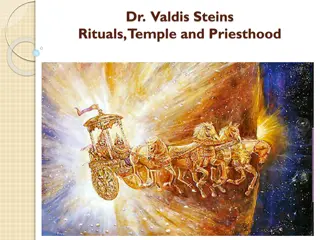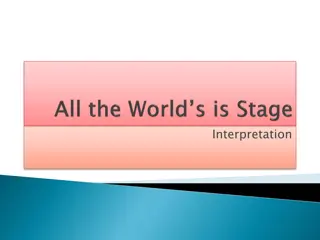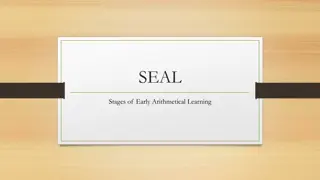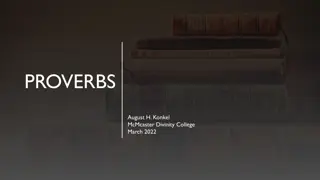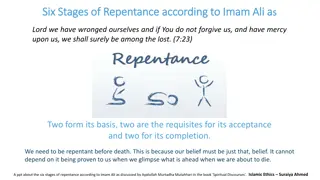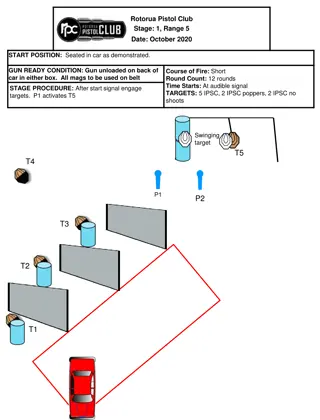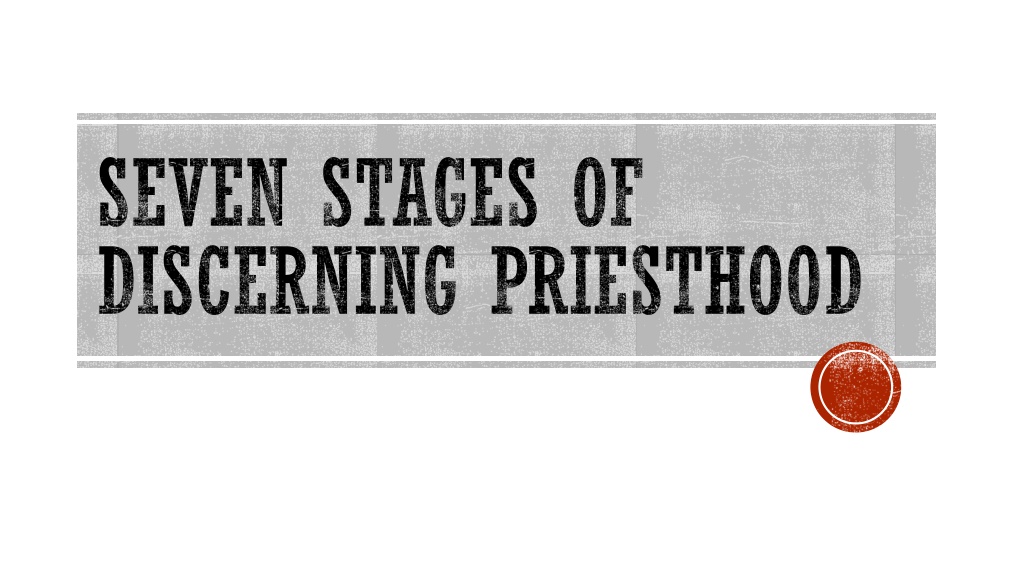
Discerning the Seven Stages of Priesthood Vocation
Explore the seven stages of discerning priesthood, from the initial call to ordination. Each man's journey is unique, filled with challenges and growth towards understanding God's will. Discover the stages and uncertainties of this sacred vocation.
Download Presentation

Please find below an Image/Link to download the presentation.
The content on the website is provided AS IS for your information and personal use only. It may not be sold, licensed, or shared on other websites without obtaining consent from the author. If you encounter any issues during the download, it is possible that the publisher has removed the file from their server.
You are allowed to download the files provided on this website for personal or commercial use, subject to the condition that they are used lawfully. All files are the property of their respective owners.
The content on the website is provided AS IS for your information and personal use only. It may not be sold, licensed, or shared on other websites without obtaining consent from the author.
E N D
Presentation Transcript
SEVEN STAGES OF DISCERNING PRIESTHOOD
STAGES Please keep in mind that every vocation is a mystery, and thus every man passes through these stages differently on the way to priesthood. Some will pass through the first few stages only to discern that God is not calling them to priesthood. Others will keep going all the way to ordination.
STAGE 1: THE INITIAL CALL A man in stage 1 has recently experienced an attraction to priesthood for the first time. This initial stage of discernment often takes place during childhood, perhaps at Mass, in a Catholic school classroom, or when a priest invites a man to consider priesthood. In this stage, a man feels an initial, mysterious attraction to become a priest, made all the more mysterious since he has almost no information about priesthood, discernment, or seminary. The primary emotions are excitement and wonder. Could God really be calling me to be a priest?
STAGE 2: LATENCY PERIOD A man in stage 2 has now been thinking about priesthood for some time, usually a few years, depending on when he entered stage 1. He is not thinking about it every day, however. Rather, more days pass when he does not think about it at all. The idea surfaces from time to time, usually at Mass, while praying at night, or when another person mentions it. He has not convinced himself that priesthood is a real possibility. Sometimes a man in stage 2 will prematurely decide that he is not being called to priesthood.
STAGE 3: ASSESSMENT PERIOD A man in stage 3 realizes that his attraction to priesthood will not go away, even though he has tried to avoid it. This man is now making a more serious effort to grow in his faith and prayer life. He may find a spiritual director because he realizes that he needs help discerning. He begins to fight the spiritual battle of surrendering to the will of God; some days he wins the battle, and other days he loses. This man s love for God is maturing and he begins to understand the joy of laying down his life for Jesus and his Church. His desire to serve others is growing, and he experiences happiness while serving.
STAGE 3: ASSESSMENT PERIOD A man in this stage is assessing specific fears now: the fear of celibacy, the fear of not being a holy priest, the fear of loneliness, and the fear of preaching in front of people.
STAGE 4: DISCERNMENT SHIFT A man in stage 4 is moving quickly towards surrender and resignation to the will of God. He has been faithful to prayer, attended retreats, gathered information, and has come to the conclusion that God is probably calling him to be a priest. He feels a sense of peace should this be his God- predetermined vocation. His spiritual director and vocation director are telling him that he has the signs and qualifications. He still may be hoping that God is only calling him to seminary for a year or so, but not to priesthood. The essential element of stage 4 is the knowledge that discernment cannot proceed any further outside of seminary. He is just spinning his wheels.
STAGE 5: SEMINARY DISCERNMENT A man in stage 5 has been accepted as a seminarian by his bishop, and the bishop has assigned him to a specific seminary. I usually associate stage 5 with the first two years of seminary, either college seminary or pre-theology. This is a very important stage in discernment. He now has a developed spiritual plan of life: he is going to Mass every day, praying before the Blessed Sacrament, and seriously studying the faith. He is living in a seminary, surrounded by other men who are also discerning diocesan priesthood.
STAGE 6: CONSISTENT PEACE This man has been in seminary from two to four years and he has grown tremendously in faith, prayer, knowledge, and generosity. This man knows Jesus personally. He has spent countless hours in prayer and study and he is very capable of teaching others about Christ. The excitement of those early years in seminary are over and he is now doing the hard work of priestly formation through daily prayer and study. This man is accustomed to the idea that he is very likely going to become a priest. He knows himself much better now, and knows that he can fulfill the duties of a priest.
STAGE 7: MORAL CERTITUDE Stage 7 begins at the very latest when a man arrives back at the seminary to begin third theology. This is not really a stage of discernment so much as an end to discernment. A man in stage 7 is no longer asking God if he should become a priest or if he has the gift of celibacy. He is preparing to be ordained a deacon at the end of third theology and then, one year later, a priest. This man has achieved moral certitude that this is God s will. He is not absolutely certain, because that is not possible, but he has received every indication that he should become a priest.
SIGNS OF A PRIESTLY VOCATION 1. God has placed in your heart a desire to be a priest. If Jesus has placed a desire in your heart for priesthood, no matter what your age, don t ignore it. Talk to a priest you admire about how you feel.
SIGNS OF A PRIESTLY VOCATION 2. You have a deep love for Christ and His Church. A priest functions in persona Christi capitas in the person of Christ, head of the Church. Thus a man who wants to be a priest must love Jesus Christ above all else. And like Jesus, he should have a deep love for the Church, the Bride of Christ. In general, a man who wants to be a priest will find himself drawn to Church teachings and all things Catholic.
SIGNS OF A PRIESTLY VOCATION 3. Other people have mentioned that you would be a good priest. Often other people will notice a priest s heart in a young man and say to him, Have you ever thought about being a priest? I think you d make a good one. In fact, many men report that they grew tired of people making such comments but that the encouragement eventually led them to seminary!
SIGNS OF A PRIESTLY VOCATION 4. You desire to live a life of virtue and prayer. Pope Benedict spoke about what people expect of their priests. To paraphrase, he said that people do not expect priests to be experts in anything but the spiritual life. Thus, a good candidate for priesthood attends Mass, prays frequently, receives the sacrament of Confession, serves others, and strives to grow spiritually.
SIGNS OF A PRIESTLY VOCATION 5. You want to help others grow closer to Christ. A priest brings Jesus to people and people to Jesus. For this reason, a man who wants to be a priest must have a deep concern for the people of God. He wants to help them grow in holiness; he wants to teach them the truths of the faith; he wants to minster to them during the trials of life. The vocation of priesthood is about leading others to heaven.
SIGNS OF A PRIESTLY VOCATION If you ve thought about the possibility of priesthood, but don t yet have all these signs and qualities, don t despair! All people must strive for holiness. And future priests go through a long and intensive formation period, precisely to help them grow in virtue and be effective in their ministry.
SIGNS OF A PRIESTLY VOCATION If you re interested in priesthood, talk to the Vocation Director about the signs above. He can help you further discern your vocation. And remember true happiness and peace depend on following God s perfect will for your life. If God wants you to be a priest, trust in his grace to lead you.
3D DISCERNMENT Stages of Discernment Desire Disposition Decision
DESIRE What do you desire? What is already placed deep within your heart that stirs? The first step in discernment is to become aware of the deepest desires of our heart and to be able to name them. This takes time and practice.
DESIRE In your journal, at the end of the day, write down to the extent that you can remember your thoughts, feelings and desires. Become aware of the interior spiritual movements of your heart. This is where God speaks to us. He does not impose Himself on us; rather, He draws us to Himself from deep within, that place of communion and discernment where God dwells in us by virtue of our Baptism.
DESIRE Once we are accustomed to becoming aware of our thoughts, feelings and desires we are ready to embark on a wonderful journey of deep personal prayer with Jesus Christ that leads to authentic and diligent discernment of God s will. Take a moment to learn some simple steps of personal prayer, ARRR.
ARRR PERSONAL PRAYER The ARRR method of personal prayer begins with unburdening your deepest thoughts, feelings and desires to the Lord, opening yourself to receive His grace, and then making an intentional response to God s love. This prayer can be done in front of the Blessed Sacrament or in the silence of your room. Don t rush through the steps. Feel free to linger with the Lord as the Holy Spirit moves your prayer.
ARRR PERSONAL PRAYER Acknowledge (A) Be still for a moment. What s going on inside you? What are you thinking, feeling, desiring? Honestly acknowledge your interior disposition. Try to be aware of both your surface- level emotions and what s going on deep in your heart. In a word: be honest with yourself.
ARRR PERSONAL PRAYER Relate (R) Now tell the Lord what s going on. Be completely real with Him and don t hold anything back. Tell him about your anger, fear, agitation, and joy. Tell him even about the small stuff. It may help to imagine Jesus sitting in front of you as you re talking to him. Let it all out.
ARRR PERSONAL PRAYER Receive (R) This step is most difficult: stop talking and listen. Be confident that God will communicate with you! Open yourself to his response. Feel his light and love. Is there a peaceful thought that keeps coming? A gentle tug in one direction? An echo of Scripture that comes to mind? Let God s grace wash over you.
ARRR PERSONAL PRAYER Respond (R) Now respond to grace. As you are walking alongside the Lord, what is your next step with him? Is he inviting a spiritual change? Renewal in how you approach a situation? Sometimes your response should be concrete, like an action to undertake today, a word to speak to a friend, or a resolution for the future.
DISPOSITION What is Your Desire when you are in Christ? Once we come to know our deepest desires, we have to ask the next question, What do I desire when I am in Christ? When I am in prayer (in Christ), what do I notice about my thoughts, feelings and desires? What do I notice about Jesus thoughts, feelings and desires that are manifested through his actions?
DISPOSITION When we are in Christ we begin to take on Christ s own disposition of heart. We begin to think, feel and desire as Jesus does as He is in the Father . The disposition that Jesus creates in us is a profound openness to do whatever the Father desires. This too takes time and practice.
DISPOSITION To be aware of our interior moments when we are in Christ means that we need to come to know Him and be with Him in Sacred Scripture. Praying with Sacred Scripture in a contemplative manner that is, placing ourselves in the scene in an imaginative way opens up new horizons of personal prayer that is rooted in Jesus own experience. Take a moment to learn some simple steps of praying with Sacred Scripture, PRRR.
PRRR PRAYER WITH SACRED SCRIPTURE The PRRR method of praying with Sacred Scripture begins with preparing your heart for deep sharing, reviewing the text slowly and prayerfully with great expectation, reflecting on the text by placing yourself completely into the scene, and responding by speaking freely with God. This prayer can be done in front of the Blessed Sacrament or in the silence of your room. Don t rush through the steps. Feel free to linger with the Lord as the Holy Spirit moves your prayer.
PRRR PRAYER WITH SACRED SCRIPTURE Prepare (P) Prayerfully choose the time, place and content of your prayer. What scripture passage has your attention? Ask the Holy Spirit to quiet and inspire you. Consider how God our Lord looks upon you as you enter into prayer. Offer your will and actions to God for His greater glory.
PRRR PRAYER WITH SACRED SCRIPTURE Review (R) This brief review of the text renders its content fresh in your mind and heart. Perhaps close your eyes and focus on the scene, letting yourself go in the Spirit. In the stillness of prayer, that Scripture is now alive in your consciousness, and you are free to enter in as the Lord desires.
PRRR PRAYER WITH SACRED SCRIPTURE Reflect (R) You are now invited to enter the place of Scripture by composing yourself imaginatively within the event described in the text. You see the persons in the event, you hear the words they speak, and you observe the actions they accomplish. From deep within the place of Scripture you now ask God what you wish and desire in this prayer.
PRRR PRAYER WITH SACRED SCRIPTURE Respond (R) As friends conclude conversation together, they may communicate with ease remaining concerns for each other. Something similar is true in prayer. As the prayer concludes you simply speak freely with God as one friend speaks to another. This is our response to God s action on us in heartfelt prayer. Naturally, it is a response of love.
DECISION Choose to Choose From our relationship in Christ we begin to know and desire God s will for our lives. The decisions we make, whether small or big decisions, are made out of a relationship of love. A daily review of our thoughts, feelings and desires in Christ is the stuff of discernment. We make a decision from the depth of this space that often comes with peace, warmth and tranquility.
DECISION To aid our daily review of interior spiritual movements, it is recommended that we pray the Examen Prayer daily as taught by St. Ignatius of Loyola. A faithful commitment to this prayer helps us to remain in communion with Jesus at every moment of the day and brings clarity regarding God s will for our lives. Take a moment to learn some simple steps for praying the Examen Prayer.
THE EXAMEN PRAYER The Examen Prayer is considered a daily instance of discernment of spirits. A faithful practice of the examen gradually helps you be aware,understand, and act according to God s will at every moment of the day. The examen helps you follow God s voice by rejecting the Enemy s. It is recommended that the examen is prayed every day in the evening hours, sometime after dinner and before Night Prayer. This prayer can be done in front of the Blessed Sacrament or in the silence of your room. Don t rush through the steps. Feel free to linger with the Lord as the Holy Spirit moves your prayer.
THE EXAMEN PRAYER Transition I become aware of the love with which God looks upon me as I begin this examen. Step One: Gratitude I note the gifts that God s love has given me this day, and I give thanks to God for them.
THE EXAMEN PRAYER Step Two: Petition I ask God for an insight and a strength that will make this examen a work of grace, fruitful beyond my human capacity alone. Step Three: Review With my God, I review the day. I look for the stirrings in my heart and the thoughts that God has given me this day. I look also for those that have not been of God. I review my choices in response to both, and throughout the day in general.
THE EXAMEN PRAYER Step Four: Forgiveness I ask for the healing touch of the forgiving God who, with love and respect for me, removes my heart s burdens. Step Five: Renewal I look to the following day and, with God, plan concretely how to live it in accord with God s loving desire for my life. Transition Aware of God s presence with me, I prayerfully conclude the examen




